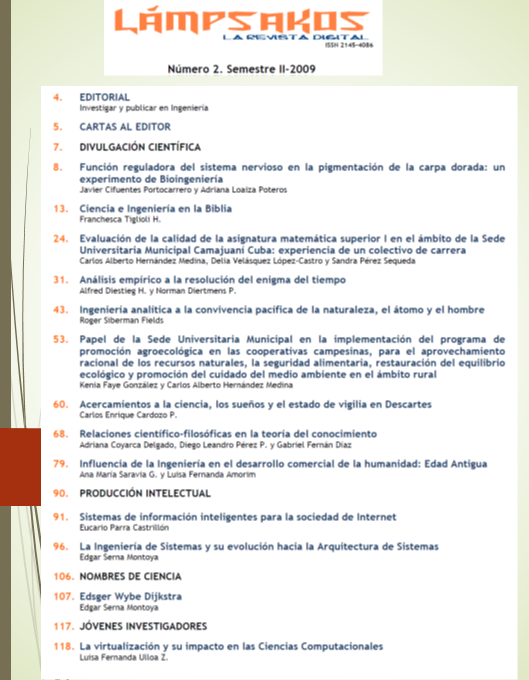La Ingeniería de Sistemas y su Evolución hacia la Arquitectura de Sistemas
DOI:
https://doi.org/10.21501/21454086.777Abstract
Muchas de las empresas modernas entendieron que sus antiguas unidades de sistemas ya no son funcionales, y comienzan a subdividirlas en dos grupos de trabajo diferenciadores: el encargado de la infraestructura y el de los denominados “arquitectos de Sistemas”. Esta decisión lógica la inspira la actual evolución de la Ingeniería de Sistemas que, como área de conocimiento, genera los mismos subgrupos como agentes para formación. Además, la evolución y complejidad de lossistemas de información en medio de la sociedad del conocimiento, con exigencias y expectativas muy complejas, también determinan la necesidad de esta especialización. En este documento, una traducción casi literal de un white paper que publicó la empresa Quidnunc -
www.quidnunc.com consultado en abril del año 2000- especializada en gestión de configuración, se detalla la importancia de esta división y las pautas a seguir a la hora de diseñar la arquitectura de sistemas de una empresa
Downloads
Download data is not yet available.
Downloads
Published
2009-06-13
How to Cite
Serna-Montoya, E. (2009). La Ingeniería de Sistemas y su Evolución hacia la Arquitectura de Sistemas. Lámpsakos, (2), 95–105. https://doi.org/10.21501/21454086.777
Issue
Section
Case report and/or divulgation articles not derivaded of a research
License
In accordance with national and international copyrights, as well as publishing policies of "Fundación Universitaria Luis Amigó" and its Journal "Lámpsakos" (indexed with ISSN : 2145-4086), I (we ) hereby manifest:1. The desire to participate as writers and submit to the rules established by the magazine publishers.
2. The commitment not to withdraw the manuscript until the journal finishes the editing process of the ongoing issue.
3. That article is original and unpublished and has not been nominated or submitted together in another magazine; therefore, the rights of the article in evaluation have not been assigned in advance and they do not weigh any lien or limitation for use.
4. The absence of conflict of interest with commercial institution or association of any kind
5. The incorporation of the quotes and references from other authors, tending to avoid plagiarism. Accordingly, the author affirms that the paper being published do not violate copyright, intellectual property or privacy rights of third parties. Morover, if necessary there is a way of demonstrating the respective permits original copyright to the aspects or elements taken from other documents such as texts of more than 500 words, tables, graphs, among others. In the event of any claim or action by a third party regarding copyright on the article, the author (s) will assume full responsibility and come out in defense of the rights herein assigned. Therefore, for all purposes, the Journal "Lámpsakos" of the "Fundación Universitaria Luis Amigó" acts as a third party in good faith.
6. In the event of the publication of the article, the authors free of charge and on an exclusive basis the integrity of the economic rights and the right to print, reprint and reproduction in any form and medium, without any limitation as to territory is concerned, in favor of the Journal "Lámpsakos" of the "Fundación Universitaria Luis Amigó".








